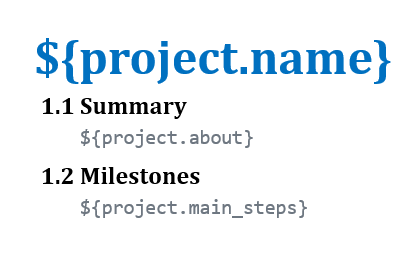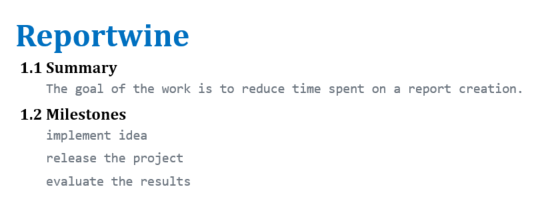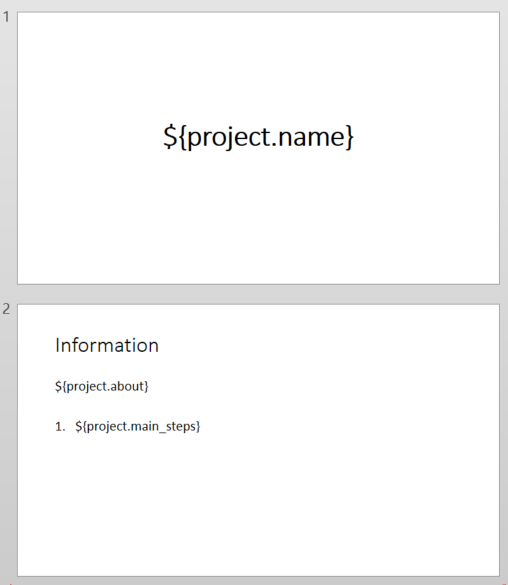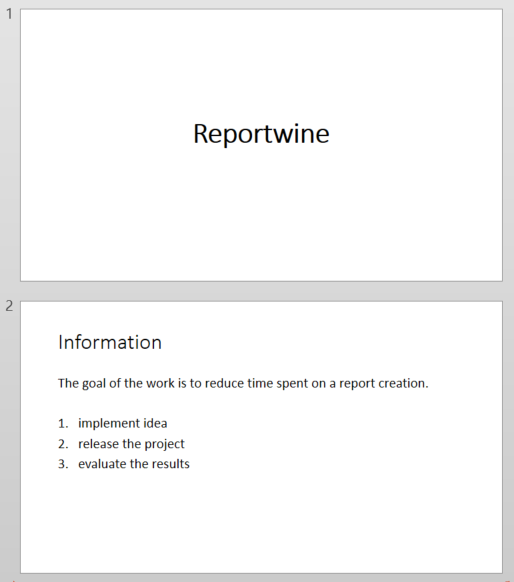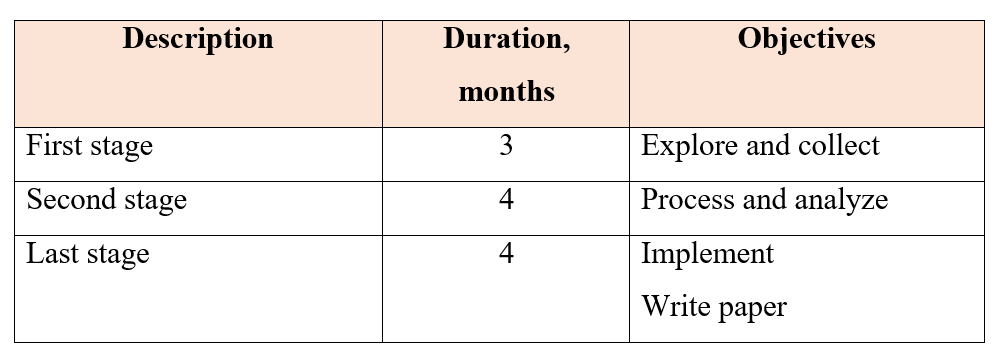Reportwine is a tool for document generation from templates and YAML files.
Supported document formats: DOCX and PPTX.
Reportwine can help you in cases if:
- you have to make reports (or other documents) periodically;
- such reports are standard, that is, they are of the same format, and only specific places of them should be changed;
- you collect data for reports during long time, or some data changes from time to time;
.docxand.pptxare the target file extensions.
Example:
Suppose, you are a project manager, and you communicate with several teams. Every 3 months you have to create a report of a strictly specified format about each team's goals, milestones, results and so on. You gather this information every week part by part. This data is unstructured. Probably it will take a long time to adjust all the information to the right format.
With Reportwine, we suggest the following solution:
- store necessary content of reports in
YAML projectfiles, which helps to structure the information from the very beginning; - create templates - reusable documents of target format that contain placeholders (variables) which will be further replaced with the content;
- include additional scripts into
YAML configurationfiles that process, collect or count information stored inYAML projectfiles.
Requirements
- Java 1.8
- Maven 3.6.3+ (to build)
Used tools
Reportwine uses the following 3rd-party libraries:
- Docx4j to generate PPTX documents
- YARG to generate DOCX documents and collect bindings for PPTX documents
- eo-yaml to parse YAML files
- GraalVM to run JavaScript snippets
How to use
Command line interface
Here and below, it is assumed that the name of the executable file is
reportwine.jar.
Syntax:
java -jar reportwine.jar
--template <path to template file>
--output <path to generated file>
--project <path to YAML file with descriptions>
--config <path to YAML file with configurations> [optional argument]
See real examples of input files and results here.
Example of how we ran one of these cases:
java -jar reportwine.jar
--template src/test/sample/complex_template.docx
--output src/test/sample/complex_result.docx
--project src/test/sample/complex_example.yml
--config src/test/sample/config.yml
Data formats
YAML project description
This section describes how you should structure content of a report in a YAML file with document descriptions.
YAML project should include a root tag for your report (by default it is set to document)
and a nested block of descriptions.
Example:
document:
descriptionsIn descriptions you have to specify a mapping of variables with values:
- variable - is a name of the placeholder in the template, where you wish to place data
- value - data to be placed instead of a variable in the target report
Text values
Suppose, there are 2 variable places in the template - project name and project summary. So, you may organize your YAML file with concrete information about some project as follows:
project:
name: MyProject
summary: The goal of work is to explore, collect data, process it, analyze, implement approach and write a paper.If the text is too long, you may use multiline block scalars in folded style:
project:
name: MyProject
summary: >
The goal of work is to explore, collect data,
process it, analyze, implement approach and write a paper.List values
To create a list you can use a YAML sequence:
project:
name: MyProject
goals:
- implement idea
- release the project
- test the projectNOTE that a sequence of text scalars when placed into
- DOCX template will look just like a list of items separated by a new line: with no bullets nor numbers
- PPTX template will inherit the style from the template: may become a bulleted or numbered list
Tables
To fill an existing table in the template you can use a YAML sequence of mappings:
project:
name: MyProject
milestones:
- description: First stage
duration: 3
objectives: Explore and collect
- description: Second stage
duration: 4
objectives: Process and analyze
- description: Last stage
duration: 4
objectives:
- Implement
- Write paperThis YAML structure specifies 3 lines of a table with the band milestones.
Such a table should have 3 columns.
Description, duration, and objectives are variable markers of the columns.
Nested structures
You may store data of nested levels for your convenience:
project:
name: MyProject
timeline:
one:
start_date: 2020
end_date:
planned: 2022
actual: 2023Scripts
Reportwine supports JavaScript embeddings as YAML values.
Include JS snippet to your YAML using the format like on the following example:
project:
name: MyProject
subproject: "$ return this.name + 'Sub';"In JS snippet you can refer to data mappings specified in the file above using this.
You may write complex multiline snippets, but they should include the return statement (at least one).
Use multiline literal block scalars to write multiline scripts with tabulation.
Examples:
project:
name: MyProject
score: 5
team:
- name: First Person
role: Project manager
- name: Second Person
role: Team leader
- name: Third Person
role: Senior developer
- name: Fourth Person
role: Middle developer
team_names: |
$ var list = '';
for (var i = 0; i < this.team.length; i++) {
if (i > 0) list = list + ', ';
list = list + this.team[i].name;
}
return list;
checkbox: $ if (this.score == 5) return '■'; else return '□';YAML configuration
We advise you to store data that seldom change in YAML project files,
and specify those data that frequently change, or scripts to retrieve new structures in special YAML configuration files.
The second type of YAML is optional one, but may become useful in case you occasionally need to change logic in processing of data.
YAML configuration file should also have a root tag. It must be similar to the one in a YAML project file.
Reportwine combines YAML structures of both files before their processing.
Template
This section describes how you should create templates.
Template is a reusable file where some parts that are expected to contain data are replaced with variables (placeholders).
Variables for text and list values should have the format: ${parent.variable_name}.
So, considering this YAML project:
project:
name: Reportwine
about: The goal of the work is to reduce time spent on a report creation.
main_steps:
- implement idea
- release the project
- evaluate the resultsand the DOCX template
the result will be the following:
for the PPTX template
the result will be the following:
Tables in templates that you want to fill with data should include a band name. You need to place it in a first cell of a first column (top left).
The format is ##band=variable_name.
A band name and a cell value should be separated by at least one whitespace, like ##band=variable_name CellData.
To specify table row data mappings, you need to add a new row and write variable names for each cell in all columns.
For example, considering the YAML sequence for table data:
project:
milestones:
- description: First stage
duration: 3
objectives: Explore and collect
- description: Second stage
duration: 4
objectives: Process and analyze
- description: Last stage
duration: 4
objectives:
- Implement
- Write paperand the DOCX template
the result will be the following:
The same is for PPTX templates
To separate data of nested variables, provide a full name of a data binding (like it is specified in a YAML file) from a root tag to a concrete nested tag.
For example, considering this structure
project:
name: MainProject
timeline:
start_date: 2018
end_date: 2022
subproject:
name: Subproject
timeline:
start_date: 2019
end_date: 2020if you want to refer to start_date, your variables should be:
${project.timeline.start_date}for main project${project.subproject.timeline.start_date}for subproject
if you want to refer to name, your variables may have short name, as they won't cause a conflict of names:
${project.name}for main project${subproject.name}for subproject
How it works
Reportwine performs the following steps:
- converts
YAML projectfile into Internal Representation (IR); - if there is a
YAML configurationfile, Reportwine also converts it into IR and merges two structures; - consequently finds
Codevalues in IR, executes them and replaces with obtained data; - converts result IR object to BandData, the structure that represents data bindings for templates;
- selects an appropriate type of generator (DOCX or PPTX), loads a template and renders a new document from it with variable replacements.

